1 Leadership 领导力
pdi通用领导力模型 思维领导力 人员领导力 结果领导力 自我个人领导力

pdi通用领导力模型思维领导力人员领导力结果领导力自我个人领导力
PDI通用领导力模型是一种广泛应用的领导力框架,它包含了多个维度,其中包括思维领导力、人员领导力、结果领导力和自我个人领导力。
1. 思维领导力(Cognitive Leadership):这个维度主要关注领导者的思考能力和决策能力。
它涵盖了领导者的战略性思维、问题解决能力、创新能力和学习能力等方面。
思维领导力对于领导者来说非常重要,因为他们需要能够思考复杂的问题,并做出明智的决策。
2. 人员领导力(Interpersonal Leadership):这个维度关注领导者与团队成员之间的关系和沟通能力。
它包括领导者的沟通技巧、建立并维护有效团队关系的能力、激励和赋能团队成员等。
人员领导力是建立良好团队合作和有效管理人际关系的关键。
3. 结果领导力(Outcome Leadership):这个维度强调领导者实现业绩和结果的能力。
它包括领导者设定目标、制定计划、执行和监督工作进展的能力。
结果领导力要求领导者具备目标导向和结果导向的思维,并能够有效管理资源,推动团队实现预期的业务成果。
4. 自我个人领导力(Self-Leadership):这个维度关注领导者的自我管理和自我发展能力。
它包括领导者的自我认知、自我激励、自我反思和自我提升等方面。
自我个人领导力对于领导者的成功至关重要,因为它涉及到领导者的个人素质、能力和内在驱动力。
这些维度共同构成了PDI通用领导力模型,它提供了一个全面的框架,帮助领导者理解和发展不同方面的领导能力。
通过发展这些领导力维度,领导者可以提高自己的综合领导能力,更好地应对复杂的挑战和变化。
leadership领导力 ppt课件

leadership领导力 ppt课件
6
1.Tannenbaum and Schmidt continuum 2.Rensis Likert Support Relation Theory 3.Chris Argyris Immature – Mature continuum 4. Blake and Mouton Managerial Grid 5.John Adair Action Centred Leadership
2. Autocratic 2 (A2) – you ask team members for specific information and once you have it, you make the decision. Here you don't necessarily tell them what the information is needed for. .
2021/3/26
leadership领导力 ppt课件
27
管理者的两种类型:
1. 任务导向型:task oriented 2. 人员导向型:relationship oriented
衡量管理情况的三个维度:
1.Position and authority 领导者的权利和地位 2.Objective structure 任务结构
Contigency Theory
三选一
2021/3/26
leadership领导力 ppt课件
26
1.Fiedler’s Contingency Theory 菲德勒的权变管理思想
中心思想:不同管理(situation)情况适用 不同领导风格(leadership behaviour)—— 把人放进情况里
leadership领导力

添加标题
添加标题
学习领导力:通过阅读、听讲座、 参加研讨会等方式学习领导力
反思与改进:通过反思和改进不 断提升领导力
实践经验
领导力的发展需要不断学习和实践 领导力的提升需要不断积累经验和知识 领导力的发展需要不断反思和总结 领导力的发展需要不断挑战和突破
反馈与反思
领导力的发展需要不断的反馈和反思 反馈可以帮助领导者了解自己的行为和决策的效果 反思可以帮助领导者总结经验教训不断改进自己的领导方式 反馈和反思可以帮助领导者更好地理解自己和他人的需求提高领导效果
领导力的应用
04
组织管理
明确组织目标:设定明确的组织目标确保 团队成员了解并认同
建立组织结构:设计合理的组织结构明确 职责和权限
选拔和培养人才:选拔和培养具有领导力 的人才提高组织整体素质
激励和激励:制定有效的激励和激励机制 激发团队成员的积极性和创造力
沟通和协调:建立有效的沟通和协调机制 确保信息畅通和团队协作
进行
成果评估: 对项目成果 进行评估总 结经验教训 为未来项目
提供参考
个人发展
自我认知:了解自己的优点和缺点明确自己的职业目标和发展方向 自我提升:不断学习新知识和技能提高自己的专业能力和综合素质 自我激励:保持积极的心态勇于面对挑战不断超越自我
自我管理:合理安排时间提高工作效率保持良好的生活习惯和健康的身体状态
团队协作
建立信任:通过沟通和合作建立团队成员之间的信任 分工合作:明确团队成员的角色和职责确保每个人都能发挥自己的优势 鼓励创新:鼓励团队成员提出新想法共同解决问题 反馈与激励:及时给予团队成员反馈和激励提高团队士气和效率
领导力的挑战与应对
05
变革管理
变革背景: 组织内外部 环境的变化
Leadership领导力教学课件
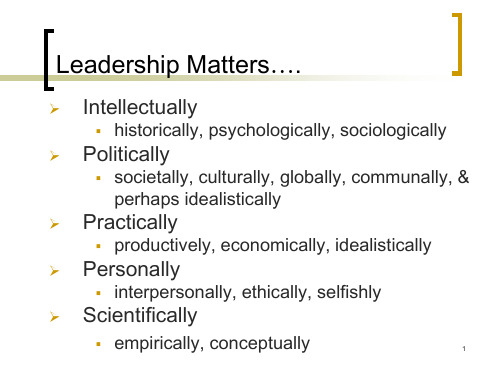
FiLedPlerC’s CSonctinagelency Theory
➢ High LPC leaders most effective in “moderately” favorable situations
➢ Low LPC leaders most effective in very favorable or very unfavorable situations
Leaders are classified as person-oriented or task-oriented (which type will be more effective depends on the leader's degree of situational control)
Control depends on relationship between leader/followers, the degree of task structure, and the leader's authority (position power)
the need for a leader)
4
Leadership myths (cont.)
➢ Leaders make or break their groups
The “romance of leadership” exaggerates the impact of a leader
Leaders do make a difference (e.g., sports teams)
Four leadership styles can be adopted to facilitate employee attainment of goals
领导力培训——团队管理和领导力

领导力提升训练
Team management and leadership
领导力提升的方法
1、领导力概述
(1)领导力就是领导获得追随者、实现共同愿景的能力。 (2)领导力分为组织领导力和个体领导力,个体领导力是组织领导力的基础。
领导力表现在三个方面:
“跟我来”
01
令人信服的远见
卓识
“看我的”令人
02
Team management and leadership
2、了解团队成员的
12个
需求
01】在工作中知道公司对我有什么期望
07】在工作中我的意见一定有人听取
02】我有把工作做好所必需的工具和设备
08】公司的使命或目标使我感到工作的重要性
03】在工作中有机会做我擅长的事 04】在过去的7天里,我出色的工作表现
Team management and leadership
3 放权的 要素
明确所要 承担的相 应责任
任务
有明确的 目标和信 息要求
权利
给予权利, 让其充分 做主
责任
单击此处 添加正文。
给你一个团队,你能怎么管?
Team management and leadership
管理者
01. 好的管理者必须是造梦大师 03. 变革,具有创新力 05. 健全制度,末位淘汰
第二维度:行为
• 行为维度的精髓在于 增进信任!
• 活在当下 • 负起责任
第三维度:空间
• 我们周围的空间有3A 个维(上下,前後, 左右)
第四维度:时间
• 已存在的影响力会随 时间的流逝而减弱
• 正在形成的影响力会 随时间的推进而增强
领导力提升训练
与领导力相关的英语词汇

与领导力相关的英语词汇以下是一些与领导力相关的英语词汇:1.Leadership:领导力2.Manager:管理者3.Supervisor:监督者4.Director:主任5.Boss:老板6.Executor:执行者7.Entrepreneur:企业家8.Managerial:管理层的9.Leadership qualities:领导力特质10.Managerial skills:管理技能11.Leadership style:领导风格12.Transformational leadership:变革型领导13.Transactional leadership:交易型领导14.Servant leadership:仆人式领导15.Authentic leadership:真诚领导16.Visionary leadership:远见型领导17.Coaching leadership:教练型领导18.Collaborative leadership:协作型领导19.Empowering leadership:赋能型领导20.Shared leadership:共享领导力21.Inspiring leadership:激励型领导22.Charismatic leadership:魅力型领导23.Visionary leadership:愿景型领导24.Values-based leadership:基于价值观的领导25.Empathetic leadership:同理心领导26.Innovative leadership:创新型领导27.Adaptive leadership:适应型领导28.Strategic leadership:战略型领导29.Coordinating leadership:协调型领导30.Decision-making leadership:决策型领导31.Organizational leadership:组织领导力32.Motivational leadership:激励动机型领导33.Analytical leadership:分析型领导34.Collaborative leadership:协作型领导35.Networks-based leadership:网络型领导36.Democratic leadership:民主型领导37.Innovative management:创新管理38.Collaborative management:协作管理39.Visionary strategist:有远见的战略家40.Change agent:变革推动者。
领导力的含义是什么
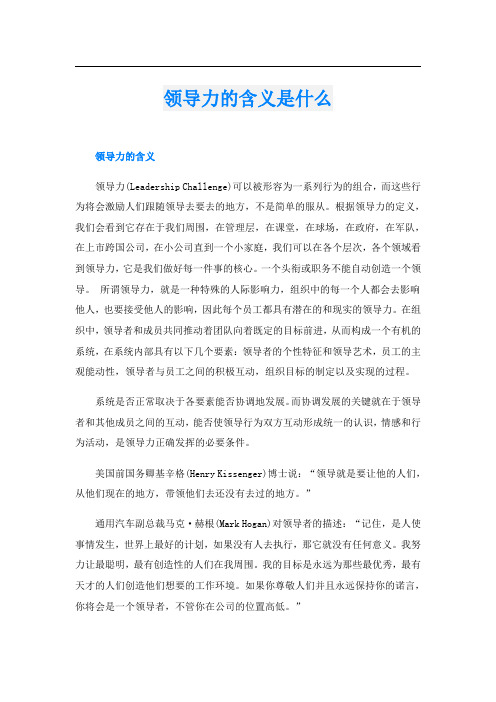
领导力的含义是什么领导力的含义领导力(Leadership Challenge)可以被形容为一系列行为的组合,而这些行为将会激励人们跟随领导去要去的地方,不是简单的服从。
根据领导力的定义,我们会看到它存在于我们周围,在管理层,在课堂,在球场,在政府,在军队,在上市跨国公司,在小公司直到一个小家庭,我们可以在各个层次,各个领域看到领导力,它是我们做好每一件事的核心。
一个头衔或职务不能自动创造一个领导。
所谓领导力,就是一种特殊的人际影响力,组织中的每一个人都会去影响他人,也要接受他人的影响,因此每个员工都具有潜在的和现实的领导力。
在组织中,领导者和成员共同推动着团队向着既定的目标前进,从而构成一个有机的系统,在系统内部具有以下几个要素:领导者的个性特征和领导艺术,员工的主观能动性,领导者与员工之间的积极互动,组织目标的制定以及实现的过程。
系统是否正常取决于各要素能否协调地发展。
而协调发展的关键就在于领导者和其他成员之间的互动,能否使领导行为双方互动形成统一的认识,情感和行为活动,是领导力正确发挥的必要条件。
美国前国务卿基辛格(Henry Kissenger)博士说:“领导就是要让他的人们,从他们现在的地方,带领他们去还没有去过的地方。
”通用汽车副总裁马克·赫根(Mark Hogan)对领导者的描述:“记住,是人使事情发生,世界上最好的计划,如果没有人去执行,那它就没有任何意义。
我努力让最聪明,最有创造性的人们在我周围。
我的目标是永远为那些最优秀,最有天才的人们创造他们想要的工作环境。
如果你尊敬人们并且永远保持你的诺言,你将会是一个领导者,不管你在公司的位置高低。
”领导力的主要类型变革型和交易型领导力变革型领导力具有强适应性,高可塑性,强灵活性等特点,它能够使团队及企业在快速变化、具有高不确定性的经济环境中更高效地生存与发展。
虽然变革型一交易型领导力的研究已经开展了20多年。
但在概念,结构,研究方法,研究方向各方面都存在一定的局限性和有待发展的窄间。
Leadership领导力演示课件
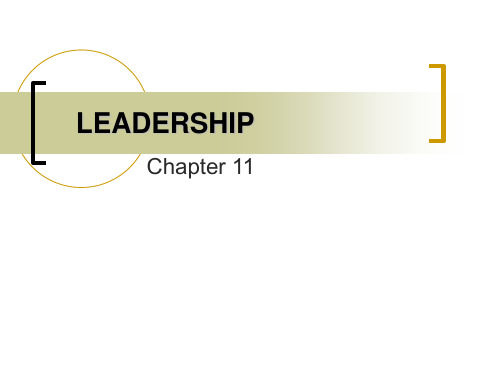
Who Will Lead? (cont)
➢ Demographic background of leaders
▪ Height, weight, & age ▪ Ethnicity ▪ Sex: Bias against women (even thought women
possess more skills needed to be a successful leader).
What is Leadership ?
“The process of influencing the activities of an organized group in its efforts toward goal setting and goal achievement” (Stogdill, 1950, p. 3)
▪ Trait Model: The great leader theory ▪ Situational Model ▪ Interactional Model: depends on the leader,
followers, and the Great Man Theory
only the great people possessed them
The Great Man Theory
➢ Personal qualities of leaders
▪ Personality traits, such as extraversion, conscientiousness, and openness.
➢ Practically
▪ productively, economically, idealistically
➢ Personally
领导力的8个能力

领导力的8个能力领导力的8个能力学习力;前瞻力;决策力;组织力;教导力;执行力;沟通力;感召力。
学习力,代表领导者超速的成长能力。
前瞻力,代表领导者的视野,决定领导是否能“做正确的事”。
决策力,代表领导者思维能力和决断能力。
组织力,代表领导者优化配置资源,实现结果转化的能力。
教导力,代表领导者带队育人的能力。
1、学习力,代表领导者超速的成长能力。
2、前瞻力,代表领导者的视野,决定领导是否能“做正确的事”。
3、决策力,代表领导者思维能力和决断能力。
4、组织力,代表领导者优化配置资源,实现结果转化的能力。
5、教导力,代表领导者带队育人的能力。
6、执行力,代表领导者实现组织目标和愿景能力。
7、沟通力,代表领导者人际平衡的能力。
8、感召力,代表领导者人心所向的能力。
领导力是什么意思大体的总结,领导力是指在管辖的范围内,充分地利用人力和客观条件,在以最小的成本办成所需的事提高整个团体的办事效率的能力。
而领导力,就是建立愿景目标的能力,是使自己与他人承诺于企业长期成功的能力,是激发他人自信心和热情的能力,是确保战略实施的能力。
而打开百度,你也可以看到千百种关于领导力的定义,都有道理但似乎又都没有说清楚。
比如说:“北京大学国家发展研究院管理学教授杨壮认为:“领导力是职场人自身所渗透出的气质,而领导则是外界赋予的权利,当下中国职场人都面临着建立领导力的难题。
”“领导力就像美,它难以定义,但当你看到时,你就知道。
——沃伦·班尼斯(Warren Bennis)“因为领导力在领导系统中是一个根本性、战略性的范畴,是领导者凭借其个人素质的综合作用在一定条件下对特定个人或组织所产生的人格凝聚力和感召力,是保持组织成长和可持续发展的重要驱动力。
当今时代,领导力已经成为综合领导能力不可缺少的构成因素之一。
领导力包括哪些能力1、学习力,是领导人超速的成长能力;2、组织力,即领导人选贤任能,整合资源的能力;3、教导力,是领导人带队育人的能力;4、执行力,表现为领导人的超常的绩效;5、决策力,是领导人高瞻远瞩的能力的表现;6、感召力,更多地表现为领导人凝聚人心的能力。
领导leadership意义

在多元化的团队中,领导者需要关注不同背景和文化下的员工需求,促进团队内部的和谐与协作。
技术变革与创新压力
技术更新换代的快速性
领导者需要不断学习新技术和知识,以适应快速变化的市场 和技术环境。
创新思维与变革能力
领导者需要具备创新思维和变革管理能力,推动组织不断适 应和引领变革。
社会责任感与可持续发展
团队协作能力
领导者需要能够与团队 成员建立良好的合作关 系,促进团队的整体发
展。
领导力的重要性
实现组织目标
领导者通过发挥自己的影响力、 决策能力和沟通能力,能够激发 团队成员的潜力,推动团队达成
目标。
提高团队凝聚力
领导者通过与团队成员建立良好的 合作关系,能够提高团队的凝聚力 和整体效率。
培养个人品质
企业社会责任
领导者应关注企业的社会责任,确保 企业在追求经济效益的同时,积极履 行对环境、社会和员工的责任。
可持续发展战略
领导者需要将可持续发展理念融入企 业战略规划,推动企业实现长期可持 续发展。
领导力发展的未来趋势
领导力培训与实践
未来领导力发展将更加注重实践与培训,通过模拟真实情境和案例分析,提高领导者的实际操作能力。
通过领导力的实践,领导者能够培 养自己的品质和能力,提升自己的 个人价值。
领导力在组织中的作
02
用
目标设定与实现
目标设定
领导者需要明确组织的目标,并 将其与团队成员共享,确保每个 人都了解并认同组织的目标。
目标实现
领导者需要制定实施计划,确保 资源得到合理分配,并激励团队 成员为实现目标而努力工作。
导师制度与指导
导师制度
01
与经验丰富的领导者建立指导关系,接受他们的指导和支持。
领导能力面试题

领导能力面试题领导力的英文拼写很形象:Leadership,一是指“领导一艘船”,亦即“领航”之意,同时也隐含着负有规避风浪的责任。
领导力是主动性和影响力的结合。
今天的顶尖企业比以往任何时候都更加依赖于各级主管和员工发挥领导力,在不确定的环境下迅速做出正确的决策、激励团队和保持高绩效。
卓越的领导力将是你征服面试官的巨大筹码。
考场实战假设公司请你担任一个团队的领导人,你认为自己最大的优势和劣势是什么?(雀巢公司)提示:应聘者在回答这类问题时,对于劣势回答需慎重,要避免恰好自己提及的缺点是这个职位不可或缺的能力要求。
另外,还可以强调对缺点(劣势)的改进方案,给面试官留下知错能改的好印象。
你还要准备几个具体事例来丰富自己的描述,增加可信度。
你可以这样回答:我认为自己最大的优势是比较稳重踏实,具有实干精神,十分有责任心。
对于一项工作,我会把它的方方面面都尽量考虑到位,清楚地分析它的利弊得失,猜测它可能的后果,我比较希望对一项工作有一定了解后再去做。
作为一名团队的领导人物,对于一些突发的紧急情况,我也能够沉着冷静地处理。
而我最大的劣势可能就是我并不那么习惯于创新。
我说自己并不习惯于创新,并不是说我不能够创新,而是我可能首先考虑的是如何有效地实施,在一开始就否决掉许多我认为无法实施的想法。
请描述你的管理哲学。
(韩国LG公司)提示:一般而言,面试官需要的很可能既不是独裁者,也不是轻言失败的人。
成功的应征者应抓住机会,表现出自己取得成功的能力。
但是也应该避免给人这样一种印象,即不惜一切人力、物力取得成功的欲望。
可以这样回答:“我认为,管理是使人们做好一项工作的最重要因素,比其他任何要素都关键。
经理的工作是给员工提供资源和有效工作的环境,我一直努力做到这一点。
我创建团队,只根据员工的表现评价他们,公平分配工作,充分授权给员工,使他们最大限度地自己决策。
我发现这样可以培育员工的忠诚度,激励他们从事艰苦的工作。
”场下演练你曾经带领团队200%地完成了团队的销售指标,成功经验是什么?提示(参考答案):“我认为这是我和我们团队成员共同努力的结果。
讲义1 领导者核心能力2018-吴维库
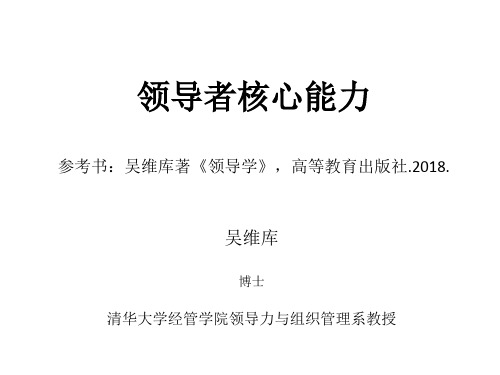
• 衡量执行力的标准: • 个人:按时按质按量完成自己的任务: • 企业:按时按质按量完成组织的任务:战略目标与布局
• 执行力:思想与行动
• • • • • 把思想变行动 把领导的思想变成员工的行动 把自己的思想变成自己的行动 把自己的思想装入别人的脑 把别人的思想变成自己的思想
• 执行力=能力*意愿*思想
领导者核心能力
参考书:吴维库著《领导学》,高等教育出版社.2018.
吴维库
博士
清华大学经管学院领导力与组织管理系教授
领导力与牛顿力学
惯性定律:
一切物体在不受外力的情况下, 总保持静止或匀速直线运动状态;
加速度定律:
物体运动的加速度与物体所受合外力成正比,与物体质量成反比,加速度方 向与合外力方向相同;
• 有效的领导有一种魅力,即某种精神力量和个人特征,能够 对许多人施加个人影响。(Max Weber) • 有效的领导应能完成管理的职能,即计划、组织、指导、衡 量。(Peter Drucker) • 有效的领导可以娴熟地组织别人做事。(Lawrence Appley) • 领导是一种影响一个群体实现目标的能力(Stephen P. Robbins)
作用力与反作用力定律:
两个物体间的作用力与反作用力在同一条直线上,大小相等,方向相反。
力的合成:
2
领导力五力模型(5F:5 force)
追随力
执行力
平衡力
影响力
领导力
• 领导力定义(已经有多于860个定义):
• 领导即使用权威与决定。(Robert Dubin) • 领导是形成一种愿景(Visioning),并能使其他人采纳这种 愿景,以推动这种愿景成为现实的人。(Jack Welch) • 有效的领导者是权力的使者,是那些能够利用技巧和手段达 到自己目标的人。(Machiavellian)
领导leadership的意义

学习与实践
学习
通过阅读、培训、交流等方式获取新知识,提升领导技 能。
实践
将所学知识应用到实际工作中,通过实践锻炼领导能力 。
反馈与评估
反馈
寻求他人的意见和建议,了解自己在领导方 面的不足。
评估
定期对自己的领导力进行客观评估,明确提 升方向。
领导力培训与辅导
培训
参加专门的领导力培训课程,系统学习领导理论和方 法。
总结词
强调集体决策,重视员工参与和意见。
详细描述
民主式领导倾向于通过讨论、协商和共识来做出决策,重视团队成员的意见和 建议。这种领导风格鼓励员工参与决策过程,从而提高员工的归属感和工作积 极性。
权威式领导
总结词
强调领导权威,决策权集中于领导者手中。
详细描述
权威式领导风格中,领导者拥有高度集中权力和决策权,通常会做出明确指示和 决策,而团队成员则负责执行。这种风格有助于快速决策和执行,但可能限制员 工的自主性和创新性。
建立良好的工作氛围
领导者应该营造积极、开放、包容的工作 氛围,使团队成员感到舒适和自在。
适应性与变革能力
拥抱变革
领导者应该积极拥抱变革,适应新的环 境和挑战,引领团队走向未来。
学习与成长
领导者应该不断学习和成长,提升自 己的专业素养和能力,以适应不断变
化的环境和需求。
创新思维
领导者应该具备创新思维,寻找新的 机会和解决方案,推动团队的创新和 发展。
03
理冲突和建立信任。
有效解决冲突
04 领导者需要有效地解决团队内部
的冲突,维护团队的和谐与稳定
。
激励与鼓舞团队士气
明确目标领导者应该明确团来自的目标和愿景,使团 队成员了解工作的意义和价值。
领导力的词源意义
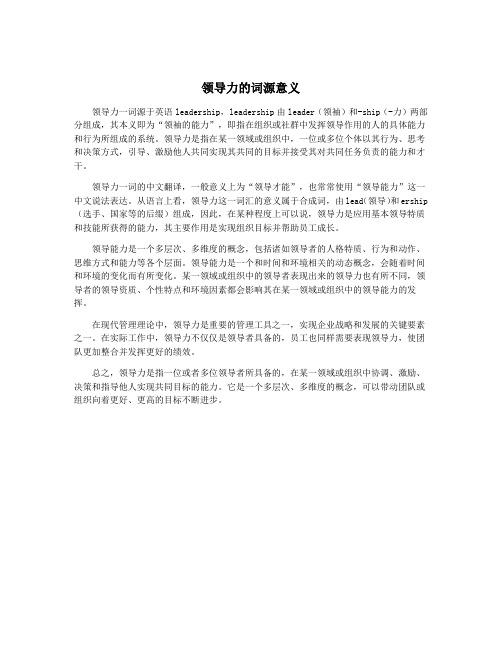
领导力的词源意义
领导力一词源于英语leadership,leadership由leader(领袖)和-ship(-力)两部分组成,其本义即为“领袖的能力”,即指在组织或社群中发挥领导作用的人的具体能力和行为所组成的系统。
领导力是指在某一领域或组织中,一位或多位个体以其行为、思考和决策方式,引导、激励他人共同实现其共同的目标并接受其对共同任务负责的能力和才干。
领导力一词的中文翻译,一般意义上为“领导才能”,也常常使用“领导能力”这一中文说法表达。
从语言上看,领导力这一词汇的意义属于合成词,由lead(领导)和ership (选手、国家等的后缀)组成,因此,在某种程度上可以说,领导力是应用基本领导特质和技能所获得的能力,其主要作用是实现组织目标并帮助员工成长。
领导能力是一个多层次、多维度的概念,包括诸如领导者的人格特质、行为和动作、思维方式和能力等各个层面。
领导能力是一个和时间和环境相关的动态概念,会随着时间和环境的变化而有所变化。
某一领域或组织中的领导者表现出来的领导力也有所不同,领导者的领导资质、个性特点和环境因素都会影响其在某一领域或组织中的领导能力的发挥。
在现代管理理论中,领导力是重要的管理工具之一,实现企业战略和发展的关键要素之一。
在实际工作中,领导力不仅仅是领导者具备的,员工也同样需要表现领导力,使团队更加整合并发挥更好的绩效。
总之,领导力是指一位或者多位领导者所具备的,在某一领域或组织中协调、激励、决策和指导他人实现共同目标的能力。
它是一个多层次、多维度的概念,可以带动团队或组织向着更好、更高的目标不断进步。
Leadership领导力PPT演示课件

Wraphic background of leaders
Height, weight, & age Ethnicity Sex: Bias against women (even thought women
possess more skills needed to be a successful leader).
Three key components to this definition:
- an interpersonal process between one person and a group
- can’t have ‘leaders’ without ‘followers’
- criterion for effective leadership = goal
Leaders are born (but leaders are also “made”) All groups have leaders (large groups tend to
require a leader) People resist their leaders (most groups accept
followers, and the group situation.
7
The Great Man Theory
Early explanations of leadership studied the “traits” of great leaders
“Great man” theories (Gandhi, Lincoln, Napoleon) Belief that people were born with these traits and
leadership 的近义词

在撰写文章之前,我想先明确一下“leadership”的概念。
Leadership(领导力)通常被定义为一个人通过影响他人来实现共同目标的过程或能力。
在这篇文章中,我们将探讨与“leadership”概念相关的近义词,并从不同角度深入了解这一主题。
1. 领导力的近义词1.1 领导才能1.2 领导艺术1.3 领导风范1.4 领袖地位1.5 领导者素养领导力不仅涵盖了对团队的管理和指导,还包括塑造组织文化、鼓舞员工和推动创新等方面。
“leadership”的近义词也应该能够体现这些方面的含义。
2. 领导力的内涵领导力是一种综合能力,包括情商、执行力、沟通能力、决策能力等多个方面。
“领导才能”这个近义词更加突出了领导力的综合性和多元化。
在组织中,具备领导能力的人往往能够影响他人、激励团队,实现组织的共同目标。
3. 领导力的外延除了在组织中展现出来的能力之外,“leadership”的近义词还应该能够体现出领导者的魅力和个人魄力。
在这方面,“领导风范”是一个更贴切的表达。
一个具有领导风范的领导者往往能够吸引和激励他人,塑造出积极向上的组织氛围。
4. 领导力的含义“Leadership”的近义词还应该能够突出领导者的社会影响力和责任感。
在这方面,“领袖地位”可以更好地体现出领导者在组织、社会中的地位和作用。
具有领袖地位的人往往能够引领行业发展,推动社会进步。
5. 领导力的修养“leadership”的近义词还应该能够体现出领导者个人的修养和素养。
“领导者素养”这个近义词更加突出了领导者对自身修养和内在修炼的重视,强调了领导者的从容和谦逊。
在总结回顾本文内容时,我们可以看到,“leadership”的近义词涵盖了领导才能、领导艺术、领导风范、领袖地位以及领导者素养等多个方面。
领导者不仅需要在管理和组织方面具备才能,还需要具备一定的领导风范和社会影响力,注重个人修养和内在修炼。
我们可以说“leadership”涵盖了更多的内涵和外延,同时也给予领导者更多的责任和挑战。
leaderships 和leaders的用法 -回复

leaderships 和leaders的用法-回复题目:Leaderships 和Leaders 的用法解析引言:作为一个广义的名词,领导力是指在组织中具备和展示出来的能够激发和指导他人并推动团队达成目标的能力。
在日常生活和职业领域,我们常常会涉及到“领导力”与“领导者”的概念。
然而,尽管这两个词经常被使用,但许多人对于它们的确切含义和用法可能存在一些困惑。
本文将一步一步解析“领导力”和“领导者”的用法,帮助我们更好地理解这两个概念。
一、领导力(Leadership)的定义和概念领导力是指一个个体在组织或团队中展现出的引导、激励和影响他人的能力。
一个拥有较高领导力的人,能够通过积极的影响力改变他人的行为、观念和态度。
领导力的核心是影响力和激发他人,并使其为了共同的目标努力。
在使用时,领导力常与其他名词连用,形成复合词,如:“组织领导力”、“团队领导力”等,旨在强调领导力是一个广泛的概念,可以应用于不同的层面和场合。
此外,领导力也常被描述为一种学习和发展的过程,通过培养和提升自己的技能和素质,个体可以成为更有效的领导者。
二、领导者(Leaders)的定义和特征领导者是具备领导力的个体,他们通过自身的远见、魅力和能力去影响和引导他人。
领导者不仅可以在组织中担任高层管理职位,也可以是一个项目经理、团队负责人,甚至是一个社会运动的倡导者。
他们通常具备以下特征:1. 视野与远见:领导者能够洞察未来的趋势和机会,以及对组织或团队的发展方向有清晰而明确的认识。
2. 激励与影响力:领导者具备鼓舞和激励他人的能力,能够通过自身的行动和言辞激发团队成员的信心和动力。
3. 沟通与协调:领导者善于沟通,能够与团队成员有效交流,并在不同利益冲突的情况下进行协调和妥协。
4. 团队建设与培养:领导者重视团队的发展和成员的培养,致力于营造积极向上的工作氛围,从而提高整个团队的绩效。
5. 适应与创新:领导者能够在变化不断的环境中灵活适应,并鼓励团队成员积极创新,以应对挑战和机遇。
领导力五力模型研究
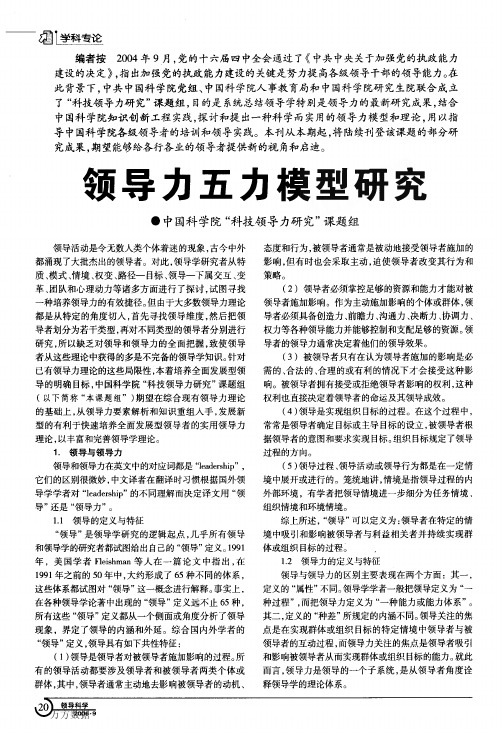
——圆1堂型童迨编者按2004年9月,党的十六届四中全会通过了《中共中央关于加强党的执政能力建设的决定》,指出加强党的执政能力建设的关键是努力提高各级领导干部的领导能力。
在此背景下,中共中国科学院党组、中国科学院人事教育局和中国科学院研究生院联合成立了“科技领导力研究”课题组,目的是系统总结领导学特别是领导力的最新研究成果,结合中国科学院知识创新工程实践,探讨和提出一种科学而实用的领导力模型和理论,用以指导中国科学院各级领导者的培训和领导实践。
本刊从本期起,将陆续刊登该课题的部分研究成果,期望能够给各行各业的领导者提供新的视角和启迪。
领导力五力模型研究●中国科学院“科技领导力研究”课题组领导活动是令无数人类个体着迷的现象,古今中外都涌现了大批杰出的领导者。
对此,领导学研究者从特质、模式、情境、权变、路径一目标、领导一下属交互、变革、团队和心理动力等诸多方面进行了探讨,试图寻找一种培养领导力的有效捷径。
但由于大多数领导力理论都是从特定的角度切入,首先寻找领导维度,然后把领导者划分为若干类型,再对不同类型的领导者分别进行研究,所以缺乏对领导和领导力的全面把握,致使领导者从这些理论中获得的多是不完备的领导学知识。
针对已有领导力理论的这些局限性,本着培养全面发展型领导的明确目标,中国科学院“科技领导力研究”课题组(以下简称“本课题组”)期望在综合现有领导力理论的基础上,从领导力要素解析和知识重组人手,发展新型的有利于快速培养全面发展型领导者的实用领导力理论,以丰富和完善领导学理论。
1.领导与领导力领导和领导力在英文中的对应词都是“leadership”,它们的区别很微妙,中文译者在翻译时习惯根据国外领导学学者对“leadership”的不同理解而决定译文用“领导”还是“领导力”。
1.1领导的定义与特征“领导”是领导学研究的逻辑起点,几乎所有领导和领导学的研究者都试图给出自己的“领导”定义。
1991年,美国学者Fleishman等人在一篇论文中指出,在1991年之前的50年中,大约形成了65种不同的体系,这些体系都试图对“领导”这一概念进行解释。
领导力或领导意愿

①领导力或领导意愿(leadership):担任过班干部或参与过竞选,积极组织或参加过集体活动者;
②团队协作能力(teamwork):能迅速与并不熟悉的人融合并展开合作(与海外伙伴配合完成任务);
③特长与爱好(interests):拥有一项特长或才艺或爱好;
④自主思考(wonder):喜欢了解新鲜事物,踊跃思考敢于提问;
⑤学习能力(learning):乐于学习一项新的技能(在海外家庭勇于担负修剪草坪、遛狗、准备西餐等家庭职责);
⑥英语交流(communication):敢于开口用英语沟通,在各类英语竞赛中获奖者;
⑦爱心与责任心(thoughtful heart):热爱生活,喜欢帮助他人,有责任心与爱心;
⑧良好风貌与礼仪(manners and appearance) : 懂礼貌有教养,能够代表中国优秀年轻人风貌;。
- 1、下载文档前请自行甄别文档内容的完整性,平台不提供额外的编辑、内容补充、找答案等附加服务。
- 2、"仅部分预览"的文档,不可在线预览部分如存在完整性等问题,可反馈申请退款(可完整预览的文档不适用该条件!)。
- 3、如文档侵犯您的权益,请联系客服反馈,我们会尽快为您处理(人工客服工作时间:9:00-18:30)。
Leadership 领导力1.Leadership is about influencing, motivation and enabling others to contribute towards theeffectiveness and success of the org of which they are members.激励感染并使他人为其所在的组织的效率和成功做出贡献2.Leaders apply various forms of influence (from subtle persuasion to direct application ofpower; leaders arrange the work environment (allocate resources and communication patterns).3.Five perspectives of leadershipCompetency (trait) perspective of leadership 胜任特征观点Behavioural 行为Contingency 权变Transformational 变革Implicit leadership 内隐领导力petency (trait) perspectiveEmotional intelligence 情商Integrity 诚实Drive 驱动力Leadership motivation 领导动机Self-confidence 自信Intelligence 智力Knowledge of the business 业务知识公司不能只停留在招聘具备相关能力的员工,还必须通过领导力发展计划和相关领域的实践经验来发展他们的潜力4.Behavioural perspective-people-oriented 员工导向trust and respect for subordinates-task-oriented 任务导向define and structure work roles, stretch goals and challenge employees, planning work activities, monitoring operations and perf.5. Contingency perspectiveMost appropriate leadership style depends on the situation.Most contingency leadership theories assume that effective leaders must be both insightful and flexible.Must be able to adapt their behaviours and styles to the immediate situation.Path-goal theory of leadership: is the prominent contingency theory that identifies 4 leadership styles- directive, supportive, participative and achievement-oriented, and several contingencies relating to the characteristics of the employee and of the situation. Other theories: situational leadership theory; Fiedler’s contingency theory (natural styles);Leadership substitute’s theory (when employees are experienced: no need task-oriented and directive styles).Factors of contingency path-goal✓Skill and experience 技能经验Inexperienced: directive and supportive✓Locus of control 控制区域more directive and supportive leadershipInternal: participative and achievement-oriented leadership stylesExternal: directive and supportive✓Task structure 结构任务Non-routine: directive styleHighly routine and simple jobs: participativeTeam dynamic 团队动力High cohesive team instead of supportive leadershipLow cohesive team, supportive leadershipTeam norms and team formal objectives: directive style“Take it easy”: legitimate style to intervenepare and contrast the key assumptions of leadershipTrait and competencyAll leaders have same personal chara, universalAll leadership qualities are equally important in all situationsCompetencies indicate leadership potentialHR implication=selection for traits, but competency can be trainedBehaviouralOverlooks the situations, universal theoryBoth task and leadership behaviours always neededHR implication=developmentalContingencyLeaders need to be insightful and adaptableBut leaders have preferred stylesHR implication=varied b/t selection and developmentTransformationalLeaders are agents of change (direction)But we need to transitional (managing efficiency) behavioursTypically been universalRelevant across culturesImplicitLeadership is overstated; there are attribution errors and uncontrollable events also abt fellowship.HR implication=need interventions other than leadership2.Difference b/t management and leadershipManagement:-Producing results through planning, organising, implementing and controlling-power base: the authority of the position that deliver compliance to an agreed performance standard-The manager’s behaviour is implemented by structure: job descriptions, policies and processesLeadership-Motivating people’s effort through conveying what can be achieved in the future through shared meaning-Building a relationship with followers that can deliver performance beyond the expected -caring: developing an emotional link with followers-Building sufficient trust and confidence so that the team willingly does what the leader requests3. Distributed leadership and self-leadershipMore appropriate in knowledge economyDistributed leadershipAn interactive influence process among individuals in groups for which the objective is to lead one another to achievement of group or org goals or bothSelf-leadershipA process through which individuals control their own behaviour, influencing themselves through the use of specific sets of behavioural and cognitive strategiesStrategies-Behaviour focused: self-awareness; set goals; monitor progress on goals-Natural rewardInternal: find aspects of the work you enjoyExternal: vacation, dinners outExcessive: self-punishment-Constructive thoughtMental imagery; positive self-talkReplace irrational beliefs/ dysfunctional。
